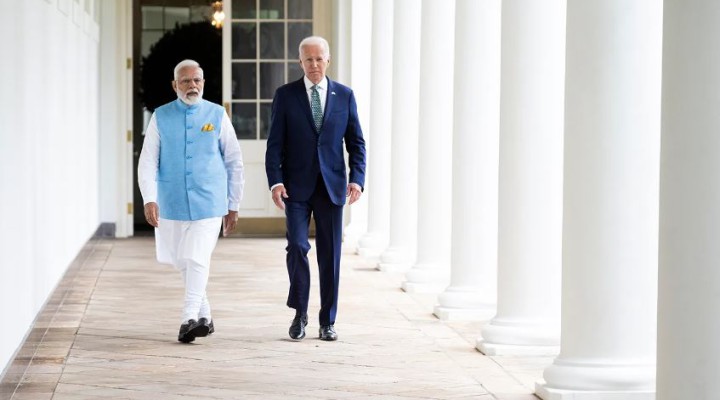Northeastern professor meets India’s PM Modi, explains the first state visit

The official state visit of Prime Minister Narendra Modi to the U.S. signified India’s arrival as a major geopolitical power, says Northeastern professor Max Abrahms, who had an opportunity to personally meet with Modi last week.
“India is currently the fifth largest economy and it’s only moving up in the ranks,” says Abrahms, associate professor of political science at Northeastern University. “This trip was an enormous deal for India, because it really signified its arrival as a major geopolitical power in a way that we’ve never seen before.”
Modi arrived in Washington, D.C., last Wednesday for a four-day state visit. His schedule was packed with meetings with President Joe Biden, Vice President Kamala Harris and other state officials, a state dinner at the White House in his honor, an address to the U.S. Congress and meetings with chief executive officers of major American companies among other commitments.
 Courtesy photo
Courtesy photo
He also met with a small group of think tankers to discuss a range of developmental and geo-political issues, according to Modi’s official website. Abrahms was one of the participants of that meeting.
Abrahms received an invitation to meet Modi from India’s ambassador to the U.S. He believes he was chosen because of his expertise on political violence and terrorism. India is very concerned with counterterrorism, Abrahms says, particularly, with radical Sunni terrorists in Afghanistan and Pakistan.
Abrahms has also participated several times at an annual international conference on geopolitics and geoeconomics in New Delhi—the Raisina dialogue—that attracts some of the most important people in the policy world, he says, including heads of state, foreign ministers and high-ranking military officials.
The structure of the meeting was very informal, according to Abrahms. The guests were not coached in advance about what they could or could not ask Modi.
Seated in a “modest circle,” each participant had an opportunity to address the prime minister or ask a question, and he responded to everyone individually through an interpreter.
As the only representative of academia, Abrahms told Modi that India is having a very noticeable effect on higher education in the U.S.
“I said that perhaps India’s greatest resource is its human talent,” Abrahms says. “I can attest that some of my very best students are from India, and one of my main co-authors is from India.”
Abrahms talked about the interface between human talent and higher education, he says.
The difficult question of human rights violations in India did come up during the meeting as well, and Modi emphasized that he values democracy, Abrahms says, and that it’s a really important basis for the India-U.S. relationship, both currently and moving forward.
Modi’s visit to the U.S. was met with mixed reactions, including criticism, protests and a boycott of his address in Congress by a few lawmakers. Modi was banned from visiting America for almost a decade, from 2005 to 2014.
The State Department denied Modi a diplomatic U.S. visa based on “severe violations of religious freedom” during deadly sectarian riots between Hindu and Muslim residents in 2002 in Gujarat, a western Indian state, where he was chief minister at the time.
Although Modi visited the U.S. several times since he became prime minister in 2014, this was the first official state visit with a red carpet and a state dinner.
Abrahms says there are several possible reasons why Modi is receiving a much different treatment now. One has to do with the rise of China.
“Increasingly, there’s concern among American officials that China will contest the United States as a hegemonic power, including in the Pacific,” he says.
India has a complicated relationship with China. It purchases more goods from China than from any other country, Abrahms says. The two countries, however, also have outstanding and sometimes active territorial disputes.
“So, the hope from American officials is that increasingly we can move India into the American sphere essentially, that if there is a war with China, India can be counted on as an ally,” Abrahms says.
A lot of concrete objectives of the trip, he says, aimed at enhancing defense ties between India and the U.S. India has purchased expensive drones and is teaming up with General Electric to develop engines for Indian fighter jets.
“India is already in what’s called ‘the quad,’ which is made up of the United States, India, Japan and Australia,” Abrahms says, “and to a large extent, the goal is to contain China.”
Another goal is to move India away from Russia and wean it off Russian weapons. The war in Ukraine reinforces the perception that U.S. weapons are superior to Russian, Abrahms says.
India has been heavily criticized for not taking a stronger stance on the war in Ukraine and maintaining trade relations with Russia.
“Prime Minister Modi says that he is pro-peace, and I share that view,” Abrahms says. “A lot of sort of hotheads in the West, who want regime change and Moscow and I don’t really partake in that kind of advocacy.”
India is hesitant about getting overly involved in great power competition, he says, to avoid going to war with either Russia or China, while maintaining strong relations with the West.
A large part of Modi’s visit was also focused on increasing business ties, taking into account that India is presumed to become the third largest economy in the world.
However, Abrahms believes, there was another domestic political component to Biden reaching out and welcoming Modi so visibly. Indian Americans constitute one of the biggest minority groups in the U.S.
“They tend to exercise their vote disproportionately more than some other groups,” Abrahms says, meaning the upcoming 2024 presidential election.
https://news.northeastern.edu/2023/06/29/northeastern-professor-meets-indias-pm-modi-explains-the-first-state-visit
 TheAltWorld
TheAltWorld 
0 thoughts on “Northeastern professor meets India’s PM Modi, explains the first state visit”